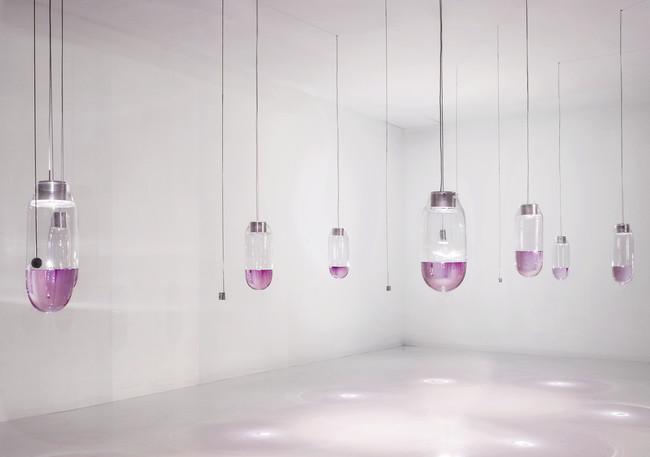
“My practice is about countering the perpetual nature of architecture,” said Simon Heijdens, a London-based designer. His hypnotic installation, consisting of nine glass vessels hung from the ceiling of a 600-square-foot booth, was a hit of the Design Miami fair—and one of many temporary engagements with architecture on display during Art Basel week.
 |
| Photo © Architectural Record Garrett Ricciardi, of formlessfinder, in front of the firm's entry pavilion for Design Miami. |
Heijdens’s vessels operate like high tech lava lamps: electronic pulses dissolve dye in the water to form ripple patterns, which are based on data recorded by wind sensors outside the building. He spent a year creating the installation, which he said was “on the border between graphics and sculpture,” under the sponsorship of the champagne company Perrier-Jouët. Next week, the piece will be in storage.
But who’s to say the temporary installation isn’t architecture? Outside the fair’s massive tent, an entry pavilion by the young Brooklyn firm formlessfinder—architects whose name is a kind of manifesto—used a sand pile as ballast to support a roof on aluminum trusses. Below the roof were aluminum formlessfinder benches that Design Miami founder Craig Robins said he had decided to transplant to his Design District, where new buildings by the likes of Sou Fujimoto, Aranda/Lasch, Johnston Marklee, and Keenen Riley are under construction. Robins has the golden touch when it comes to picking architects: Aranda/Lasch, David Adjaye, and Snarkitecture have created Design Miami pavilions before going on to bigger things.
As a proving ground, the annual pavilion commission has come to resemble the Young Architects Program sponsored by MoMA PS1, the Museum of Modern Art’s contemporary art space in Queens, New York. But if the Young Architects creations—pavilions in the PS1 courtyard—are aimed mostly at 20-somethings, Design Miami attracts an older, well-heeled crowd (including, this year, architectural grandees Jean Nouvel, Richard Meier, and Norman Foster).
Meanwhile, in a corner of the Design Miami tent, a show organized by Terence Riley, the former MoMA curator of architecture and design, featured detailed plans for an apartment complex in Coconut Grove, designed by OMA, as well as the “losing” designs of Nouvel, Christian de Portzamparc, and Diller Scofidio + Renfro. (Riley ran an informal competition on the developers’ behalf.) It will take time, and hard work, Riley said, for the slick models and renderings to become real buildings. Heijdens’s installation will have come and gone before OMA’s complex breaks ground.

Post a comment to this article
Report Abusive Comment